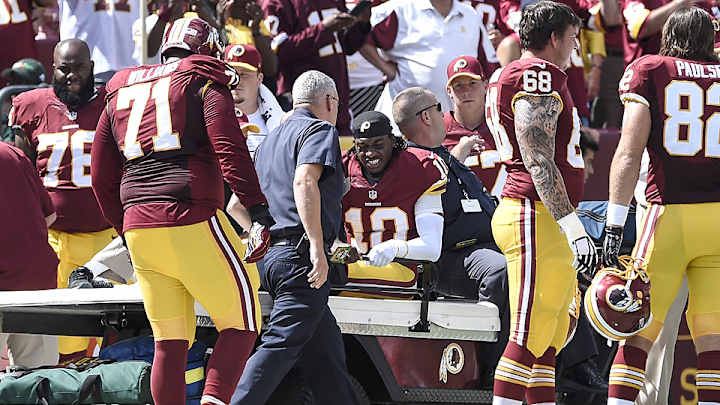Everybody Hurts

Sunday was a brutal day for injuries.
Robert Griffin III, DeSean Jackson, A.J. Green, Gerald McCoy, Eric Berry, Ryan Mathews, Knowshon Moreno, Jamaal Charles, Tavon Austin, Jason McCourty, Eric Decker—those stars were among the 35 players (and counting, most likely) who were forced from games with various injuries.
Add that to the 55 who exited games and did not return in Week 1, and it seems as if injuries have risen to an epidemic level in 2014.
But is that truly the case, or are we just so close to it that we think it’s worse than it is?
It appears the latter is true. Going back through last year’s media reports and the injury report for Week 3 (to see which players couldn’t practice that week), there appeared to be just as many injuries, and key ones at that, in Week 2 of the 2013 season.
One year ago, the list of players who exited games and did not return included Reggie Bush, Larry Fitzgerald, Eddie Lacy, Andre Johnson, Steven Jackson, Ray Rice, Maurice Jones-Drew, Ryan Clady, Rodger Saffold, Eric Reid, Russell Okung, Vernon Davis, Sam Baker, Duane Brown and most of the Panthers’ secondary.
“No matter what you do you can’t make your foot bigger,” Chao said. “You’re planting a bigger tree in the same pot. That’s one of the reasons why we’re seeing a rise in Achilles tendon ruptures.”
Just another bloody Sunday in the NFL. But there is at least anecdotal evidence that suggest injuries continue to rise each year, and the NFL may need to do something (expand the rosters?) to deal it.
Our friends at FootballOutsiders.com have a stat called “Adjusted Games Lost” for starters and important situational players on each team. The team average in 2006 was 38.1. It nearly doubled to 70.7 in 2013.

One trend you’ll notice in the chart is that injuries took a big jump from 2010 to ’11 and have risen steadily since then. The lockout occurred in the summer of ’11, and the new practice policies (limited padded practices, no two-a-days in training camp) have been in place since then. Some coaches think the new rules don’t allow the players’ bodies to get acclimated to the physicality of the regular season.
• ‘FOOTBALL IS FULL OF HEART’: Bengals DT Devon Still and his daughter's fight against cancer
“Personally, I think that's taking the wrong approach,” Patriots coach Bill Belichick said last season. “You have a gap between preparation and competition level. And I think that’s where you see a lot of injuries occurring. We get a lot of breakdowns. We get a lot of situations that players just aren't as prepared as they were in previous years, in my experience anyway.”
Knowshon Moreno, who suffered a dislocated elbow, was one of the many stars to go down on Sunday. (Bill Wippert/AP)

Orthopedic surgeon Dr. David J. Chao, the former team physician for the Chargers with 17 years of NFL experience, doesn’t necessarily agree with Belichick.
“If that were true, in theory, after a handful of games there should be less injuries,” Chao said. “I don’t know if we see that. It would explain the rise in injuries the first two weeks, but then we should see a drop.”
Chao has long subscribed to the “bigger, faster, stronger” theory that players are simply much bigger than they once were, and their lower bodies aren’t designed to handle that.
“No matter what you do you can’t make your foot bigger or stronger,” he said. “The base is the same. You’re planting a bigger tree in the same pot. That’s one of the reasons why we’re seeing a rise in Achilles tendon ruptures. It’s the new ACL.”
The lack of testing for HGH certainly didn’t help combat players getting too big for their lower bodies. There’s also the issue of footwear. Most positions now are wearing the kind of cleats receivers wore a decade ago.
Injuries could indeed be on the rise, but there could be some simple explanations for why they seem more prevalent.
There is an increased awareness league-wide, from fans and media to detailed injury reports, about injuries. Reporting is better—immediate and more precise. The concussion protocol has certainly kept players off the field, to the point where now it’s rare to see a player leave for testing and then return to a game. And the players themselves are so much better informed. They understand the long-term effects of injuries and may not be pushing to return as quickly, especially early in the season. The use of painkillers, like Toradol, has also subsided. Players who used to get shot up for broken ribs or hands in order to play may be taking a pass on an injection because of possible long-term effects.
• PETER KING'S MAILBAG: Readers respond to Peter's column ‘Should We Still Like Football?’
What seems to be agreed upon is a need for more studies about the injury rates in the NFL. The league and NFLPA were contacted for this story. The NFL said they couldn’t provide any data. The NFLPA says they don’t track injuries. That seems a bit unbelievable. And if it’s indeed true, that shows you the level of concern.
“There certainly appears to be a correlation between the practice changes and increased injuries,” said former Raiders president Amy Trask, a CBS analyst. “Now, we have to determine if it is not just correlation, but causation.”

